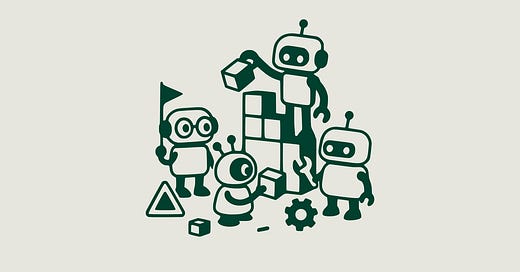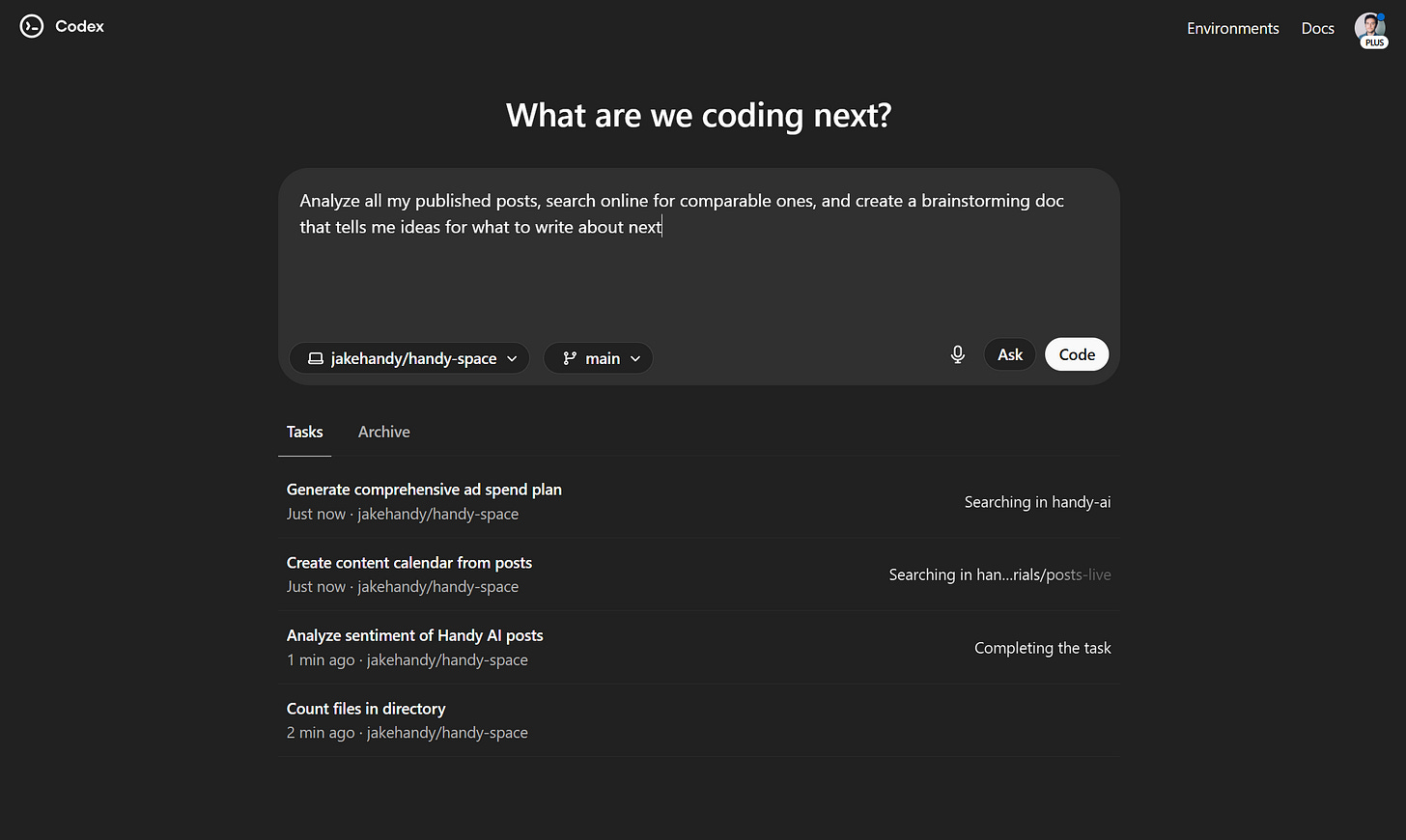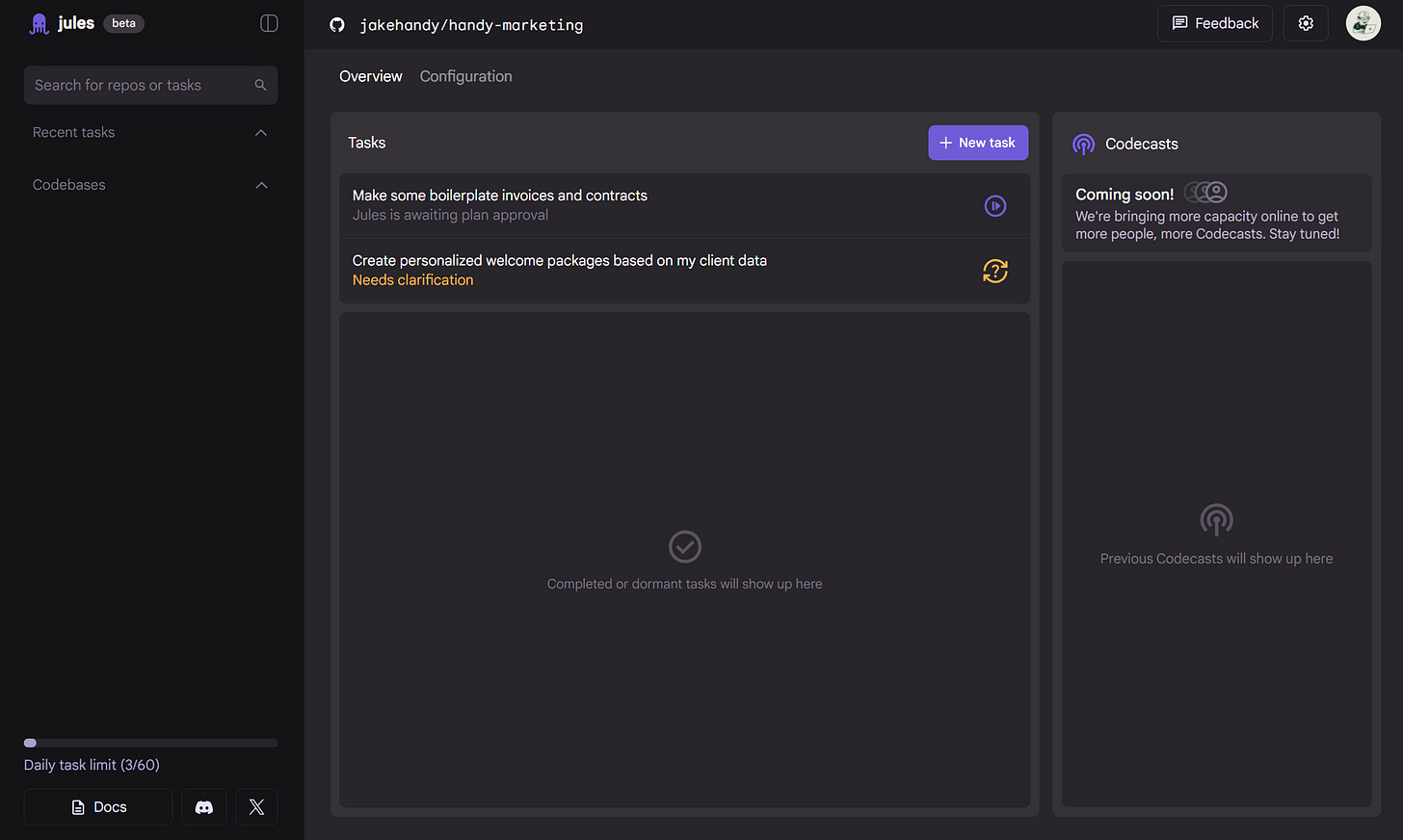Remember when we talked about turning Cursor into your digital command center? That was just the beginning. As AI tech continues to progress rapidly, it no longer just assists you; it works for you. Autonomously. In the background. While you sleep.
Welcome to the age of the AI workforce.
What makes async agents different
Traditional AI tools like ChatGPT or Claude require constant conversation. You ask, they respond, you ask again. It's reactive. Async agents are proactive. Give them a goal and they'll figure out how to achieve it, step by step, without you holding their hand.
Google's Jules, which entered public beta last month, exemplifies this perfectly. As Google describes it, Jules is "an asynchronous, agentic coding assistant that integrates directly with your existing repositories.” Swap the word “repositories” here with “computer files” and you start to get the picture.
Imagine you're running a consulting business. Before bed, you tell Jules to "research our top three competitors, create a market analysis report, and draft a competitive positioning strategy." You wake up to a complete 20-page analysis sitting in your Cursor workspace, with all sources cited and recommendations ready for your morning client call.
This isn’t science fiction, it’s Tuesday.
The big three
In the past few months, three platforms have emerged as the leaders in async AI agent technology. Each has its own strengths (and weaknesses), and understanding which to use when is important.
OpenAI’s Codex: The production powerhouse
OpenAI's Codex, launched last month, is the current gold standard of production-ready AI agents. Built on the specialized codex-1 model (a fine-tuned version of OpenAI's o3), Codex achieved 75% accuracy in coding tests.
What makes Codex different:
Enterprise-grade integration. Seamlessly built into ChatGPT (for Plus and Pro users), with robust enterprise and team plans
Isolated sandbox environment. Operates in a secure, air-gapped virtual machine with opt-in internet access for maximum security
Multi-task parallel processing. Can handle multiple complex projects simultaneously in separate virtual environments
Production reliability. Designed for mission-critical business applications with comprehensive error handling
Perfect for:
The solo builder using ChatGPT for all their current needs
Businesses needing reliable, consistent output
Teams requiring enterprise-grade security and compliance
High-volume processing tasks that need parallel execution
If you’re looking to prioritize security, opting out of internet access limits Codex's ability to find external documentation or APIs during execution, limiting some real-time research capabilities. But for folks that need dependable, production-ready automation, it's the clear choice.
Google’s Jules: The experimental innovator
Jules is Google’s Codex. Built on Gemini 2.5 Pro and currently in public beta, Jules is being run as an experimental test (with free access!). While it lacks Codex’s enterprise polish, it’s abilities are nearly on par.
What makes Jules unique:
Free public beta. Available to everyone worldwide, no subscription required during beta phase
Internet connectivity. Jules can access external documentation and APIs in real-time
Audio summaries. Unique feature that creates spoken summaries of completed work (dubbed “Codecasts”)
Transparent planning. Shows its reasoning process step-by-step before execution
Prototype flexibility. More experimental features and (likely) rapid iteration cycles
Perfect for:
Solo builders and small teams experimenting with AI workflows
Users who want cutting-edge features without financial commitment
Teams comfortable with beta software and occasional limitations
As one detailed review noted: "After testing it thoroughly... apart from a few basic tasks, we couldn't find any relevant use cases for a real project." Jules is innovative but still finding its footing as a production tool.
Claude Code: The strategic consultant (Advanced tier)
Anthropic's Claude Code is here as our premium tier of async agents, with a steeper learning curve in its current CLI-only iteration. Industry analysis points out that Claude Code's "constitutional AI approach means it creates detailed plans before executing, allowing you to review and approve complex operations before they begin."
Perfect for:
High-stakes projects requiring deep reasoning
Complex strategy development
Situations requiring ethical consideration
An agent your dev team may better appreciate
When you need the AI to "think" before acting
Claude Code strategizes, considers implications, and presents you with thoughtful recommendations. When you're making decisions that could impact your business significantly, Claude Code's more deliberative approach could be the better path.
Real-world async workflows (that actually work)
The power of async agents becomes clear when you see them in action on everyday business tasks. Here’s a few scenarios where this tech can change how you work:
The content creation pipeline
Sarah runs a B2B consulting firm. Every month, she needs to produce:
4 detailed industry reports
12 LinkedIn articles
20 social media posts
A monthly newsletter
Her old workflow: A week of grinding, missing deadlines, and working overtime.
Her async workflow: Sunday evening, she feeds Jules her content calendar and research sources. By Monday morning, she has draft reports waiting for review. That same morning, Codex has generated social media content variations. By Tuesday, she's reviewing and refining instead of creating from scratch.
Result: Same quality output, 80% less time investment.
The market research powerhouse
Tom owns a chain of local restaurants and needs to stay competitive. Every quarter, he needs comprehensive market analysis of:
Competitor pricing strategies
Customer sentiment analysis
Local food trend identification
Supplier cost comparisons
His async approach: Tom sets Codex to work analyzing competitor menus and pricing. Jules monitors review sites and social media for customer sentiment. Claude Code synthesizes everything into strategic recommendations.
By the time Tom sits down for his quarterly planning session, he has a complete market picture with actionable insights (and not just the typical data dumps).
The small business automation suite
Maria runs a boutique marketing agency with three employees. She's used async agents to automate:
Client onboarding. Jules creates personalized welcome packages
Proposal generation. Codex adapts templates based on client data
Campaign performance analysis. Claude Code provides strategic insights
Invoice and contract management. Jules handles the paperwork
This asynchronous dance of agents allows her team focuses entirely on creative work and client relationships while the AI workforce handles operations.
Setting up your async workspace
The beauty of async agents is that they integrate seamlessly with the Cursor/Windsurf workspace you're already using. If you’re unsure how to get that initial AI workspace set up, check out our guide:
Then, load up your agents:
Jules
Jules offers the lowest barrier to entry:
Visit jules.google (No subscription required during beta)
Connect your GitHub account. One-click OAuth integration
Select a repository and branch (your Cursor workspace). Jules clones it to a secure Google Cloud VM
Write detailed prompts. The more specific, the better results
Review and approve plans. Jules shows its reasoning before executing
Jules works best when you give it clear, structured goals. Instead of "research competitors," try "analyze the pricing strategies of [Company A], [Company B], and [Company C], focusing on their premium service tiers, and create a comparison table with recommendations for our positioning."
Codex
Codex requires a ChatGPT Plus or Pro subscription but delivers enterprise-grade capabilities:
Access through ChatGPT sidebar. Find the "Codex" option
Set up multi-factor authentication. Additional security layer required
Connect GitHub repositories. Choose which repos Codex can access
Configure environment variables. Set up secrets and configurations (optional)
Queue multiple tasks. Take advantage of parallel processing
The key with Codex is to think in terms of scale and reliability. Don't ask it to write one email. Ask it to create email templates for 12 different customer scenarios, test them for deliverability, and generate performance tracking codes.
Claude Code
Claude Code requires a more technical setup:
Install Node and the Claude Code CLI. Install Node 18+ and then the CLI tool with
npm i -g @anthropic-ai/claude-code.Login and authorize. Run
claude loginin your Cursor/Windsurf terminal, which will let you login via the Claude console (for usage-based pricing) or Claude app (if you’re a subscriber). Finish OAuth and it’ll save your token to~/.config/claude-codeConnect it to your AI workspace. Inside your workspace, run
claude init. This will writeclaude.yamlandCLAUDE.mdwhich you can modify to give Claude your workspace’s context.Chat and work together. Talk with Claude in the terminal, or fire up
claude run <task>to drive edits, commits, whatever.
When you ask Claude Code to "develop our Q2 marketing strategy," it won’t just generate tactics, it’ll analyzes your market position, considers budget constraints, evaluates risk factors, and present a comprehensive strategy with multiple scenarios.
Managing your AI workforce
Just like managing human employees, managing AI agents will require clear communication, defined roles, and performance monitoring.
Setting clear expectations
Be hyper-specific about outcomes. Instead of "write a report," try "create a 10-page competitive analysis including pricing comparison tables, SWOT analysis for each competitor, and three strategic recommendations with implementation timelines."
Define quality standards. Give examples of good and bad outputs. The more context you provide, the better your agents perform. The quality of your prompts is just as important here as it is with generative models.
Establish timelines. While agents work fast, complex tasks can take time, and as these bots continue to get more advanced those timelines will expand as well. Set realistic expectations for deliverables.
Quality control processes
Even the best AI agents need oversight:
Review outputs before you send them off to your workspace. The agents will show you what work they’ve done, and you’ll have to approve this work and push it to your GitHub workspace repository. Take this step seriously and don’t ship anything to your workspace that could be a organizational (or security) headache.
Spot-check routine work to ensure quality remains high.
Provide feedback to improve future performance. Refine your prompts as you learn what works (and what doesn’t).
The future of work
We're still in the early days of async AI agents, but the future is clear.
It’s not unlikely that these type of async bots will change the nature of work itself. When routine tasks are handled autonomously, humans become curators, strategists, and creators rather than executors. We talked about this extensively early this year, and these sorts of workflows are the first step to human work extinction.
It’s important to remember that the workforce outlined here is refitting coding bots for non-coding work. While this works well, we’re still having to navigate through things like repositories and merge requests that aren’t necessarily needed for non-coding tasks. As async agents continue to prove their grit in coding spaces, ones specialized for non-coding will emerge. Combine this with the promise of computer use agents and we’re looking at something else entirely.
What's coming next
🧠 Improved reasoning capabilities. Agents will handle increasingly complex decision-making scenarios. With next generation models like GPT-5 right around the corner, expect these agents’ reasoning to improve quickly.
🔗 Better integration. Seamless workflows between different agent types and human tools, and move away from coding-exclusive async agents to more general purpose computer use ones.
🏭 Industry specialization. Agents trained specifically for law, medicine, finance, and other verticals.
🤝 Real-time collaboration. Agents that can join meetings, take notes, and follow up on action items automatically. Set it free with an intended goal and let it move where it needs to.
🤔 Predictive workflows. Agents that anticipate your needs and start working before you ask.
Getting started today
The businesses that thrive in the async AI era will be those that:
Embrace experimentation with new workflows.
Invest in training their teams to work alongside agents.
Focus on high-value human skills like strategy, creativity, and relationship building.
Build robust quality control processes for agent outputs.
Maintain human oversight of critical decisions.
Async agents are here, now. Jules is available to everyone for free during its beta, Codex is rapidly expanding access, and Claude Code (with Sonnet 4 onboard) is setting the standard for premium AI assistance.
The question isn't whether this technology will change how you work. The question is how you'll adapt to leverage it, or whether you’ll watch competitors pull ahead while you're still doing everything manually.
Start small: Pick one routine task that consumes too much of your time. Set up an async agent to handle it. Experience the magic of waking up to completed work. Then gradually expand to more complex workflows.
The modern AI workspace was about establish a foundation for your day-to-day work to function with AI. The modern AI workforce is about giving you back your time. And as agents multiply and assimilate, time becomes the competitive advantage.














Just sharing, I hope you do not mind.
The True Threat of AI is Global Compute Governance, Job Loss, and Economic Displacement https://torrancestephensphd.substack.com/p/the-true-threat-of-ai-is-global-compute